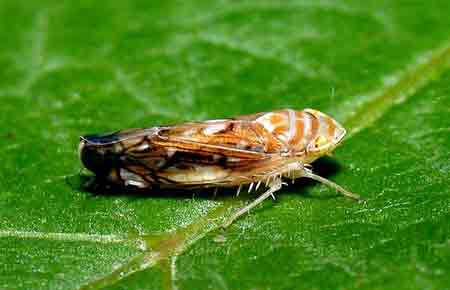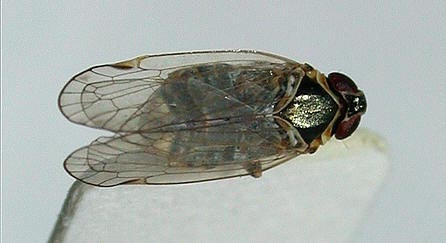|
Scaphoideus titanus (Auchenorrhyncha: Cicadellidae) is monophagous species feeding only on grapevine. This leafhopper is the only known vector of phytoplasma Flavescence dorée (16SrV-C). Considering its narrow host range, S. titanus affects the rapid spread of phytoplasma inside vineyard and to neighboring vineyards. It has one generation per year and overwinters in stage of egg. Female oviposits under bark of 2 year or older shoots. In north Italy and France larva start hatching in mid May, while first adults emerge at the beginning of July (Lessio et al., 2003; EPPO-dsqpSTOL; Alma, 2002). Preliminary surveys of S. titanus phenology in Serbia, showed the beginning of larva hatching also in mid May, while emergence of imagoes is registered in third decade of June. This corresponds to period of 35-40 days neccessary for larval development to adult. Imagoes are present till end of September. Differences in phenology of S. titanus in Serbia can be expected, especially between populations in northern and southern regions. S. titanus has 5 larval instars. First three instars are pearl white, fourth and fifth have brown scattered spots on back with visible wing rudiments. All larval instars have lateral black spot on last abdominal segment. Imagoes are around 5mm. Head is triangle. Forewings are elongated, slightly overpasing the end of abdomen when folded. On last abdominal segment imago has dark brown bristles which exceeds the edge of wings. All larval stages and imagoes feed on grapevine leaves. When feeding on infected plants, leafhopper is sucking in a phloem content, ingesting phytoplasma as well. Development of S. titanus from L1 to adult takes about 35-40 days. Incubation period of pathogen (FD) in larva, untill they get infected, is about 3-4 weeks. Hence, all larva feeding on phytoplasmatic plants become infected at the end of third larval instar and they continue to transmit the phytoplasma untill the end of life cycle. Practically, all larval instars older than L3 and imagoes feeding on infected plants, transmit disease to healthy plants. |
|||||
|
|
|||||
|
Scaphoideus titanus Ball (Auchenorrhyncha: Cicadellidae), vector of phytoplasma Flavescence dorée |
|||||
|
Hyalesthes obsoletus Signnoret, 1865 (Auchenorrhyncha: Cixiidae) is polyphagous species known as vector of Stolbur phytoplasma (16SrXII-A) on grapevine. It's common species on bindweed (Convolvulus arvensis, Convolvulaceae), also present on nettle (Urtica spp.), Ranunculus spp., Senecio spp. and Artemisia spp. Less frequently registered on other herbs, woody plants, fruits and grapevine. Imagoes are active from the end of May till mid August. This leafhopper has one generation per year and overwinters in larval stage. Dimensions of adults vary from 3 to 6 mm. Females are larger than males. Larva live in soil and feed on roots of host plant. In situation when high percent of phytoplasmatic plants is present, which is often the case with bindweed or nettle, infection with phytoplasma can occur in larval stage, which explains high percent of infected grapevine plants (Palermo et al., 2004). Altough Hyalethes obsoletus is not frequent in vineyards, its role in transmission of Stolbur phytoplasma is significant because it inhabits xerothermic stands suitable for grapevine breeding (Palermo et al., 2004). On the other hand, bindweed is most certainly one of the commonest and most persistant weeds in vineyards of Serbia. Phytoplasmatic plants of bindweed were often found during preliminary surveys in 2004. This cicada is known as vector of Stolbur phytoplasma on tomato and potato (EPPO-RS, 2004). |
|||||
|
|
|||||
|
Hyalesthes obsoletus Sign. (Auchenorrhyncha: Cixiidae) vector of Stolbur phytoplasma |
|||||
|
Reptalus panzeri (Löw, 1883) [Auchenorrhyncha: Cixiidae]. Common species in Serbia. Imago 6 - 9 mm. Polyphagous, has one generation per year and larva overwinters. Imagoes are active from mid June till beginning of August. In Serbia, it's registered feeding on weeds, crops, shrubs and trees (Prunus spp., Rosa spp.). In Hungary it was identified as vector of Stolbur phytoplasma in vineyards (Palermo et al., 2004), with more significance than the other vector Hyalesthes obsoletus, considering its wide host range and frequent feeding on grapevine as alternative host. Importance of this cicada in transmission of phytoplasma is directly correlated with phytosanitary status of plants larva feeds on (how frequent are phytoplasmas on them), i.e. risk of larva getting infected with phytoplasma during development. Considering the short period of insect activity (around 45 days), only imagoes infected with phytoplasma in larval stage can affect the significant spread of infection in vineyards. It inhabits xerothermic sites, thus is often found in vineyards. |
|||||
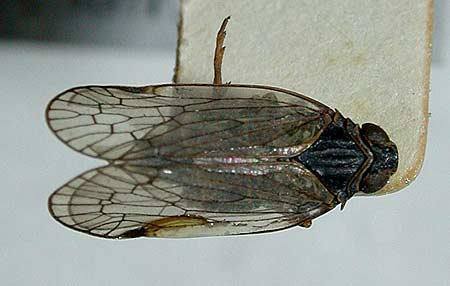 |
|||||
| Reptalus panzeri (Löw, 1883) (Auchenorrhyncha: Cixiidae) vector of Stolbur phytoplasma | |||||
|
|
|||||
|
Reptalus quinquecostatus (Dufour,1833) [Auchenorrhyncha: Cixiidae]. Frequent species in Serbia. Inhabits different stands, mostly dry and warm, but is relatively common along river sides. Polyphagous species with practically unknown biology, registered in Serbia in crops, especially corn fields. There is a possibility that several species were described under this name (Holzinger et al., 2003). It overwinters in larval stage. Imago emerges later than R. panzeri from beginning of July till beginning of August. R. quinquecostatus is most common on same sites as R. panzeri, from which it can be distuinguished by enhanced stripes on pronotum (ridges) and morphology of male genitalia. |
|||||
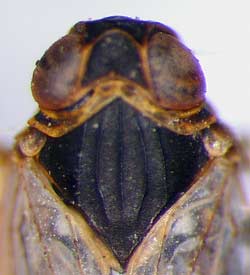
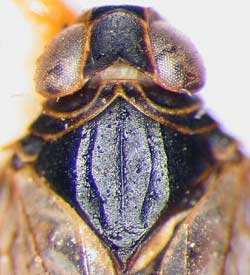 |
|||||
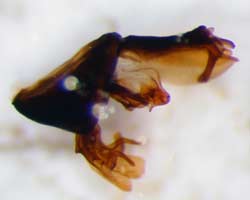
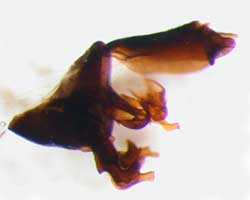 |
|||||
| Reptalus quinquecostatus | Reptalus panzeri | ||||
| (Dufour,1833) | (Löw, 1883) | ||||
|
Cixius wagneri China, 1942 [Auchenorrhyncha: Cixiidae]. It was registered as common species on Mt. Fruska Gora. Overwinters in stage of larva. Imagoes are active from the beginning of April till end of September. C. wagneri inhabits semi-open stands, often present in vineyards (Holzinger et al., 2003). It’s polyphagous and feeds on deciduous trees, shrubs and tall-growing herbs. Role of this cicada in phytoplasma transmission is not yet clear. During preliminary survey in Serbia, this species was often registered on grapevine plants with symptoms of phytoplasma infection. |
|||||
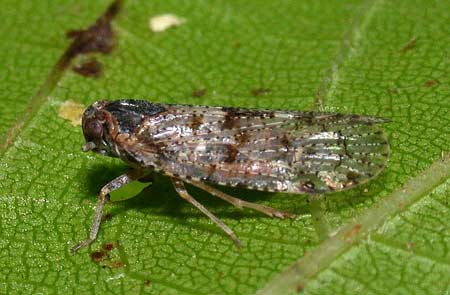 |
|||||
| Cixius wagneri China, 1942 (Auchenorrhyncha: Cixiidae) | |||||
|
Fieberiella florii (Stäl, 1864) [Auchenorrhyncha: Cicadellidae]. Polyphagous species living on woody plants. Imago is 6 - 8 mm. Has one generation a year and overwinters in stage of egg. Imagoes emerge from the beginning of June till end of October. Frequent species in open shrublands and along various margins, mainly in dry grassland with scattered shrubs, but also in ruderal sites, along rivers, streams and hedges, in parks and gardens. Host plants are usually species from genera Rosa and Prunus, Ligustrum vulgare and Rubus idaeus. Single specimens were found on Quercus, Ulmus, Cytisus, Salix, Syringa, Elaeagnus, etc. (Biedermann and Niedringhaus, 2004). In Serbia it’s very frequent on grapevine, especially leaves with discoloration due to phytoplasma infection. Fieberiella florii is known vector of phytoplasma from X-disease group (16SrIII-A) on peach in North America (Arzone and Alma, 2000). Its role in transmission of phytoplasma in Serbia is so far unclear. On several localities in Serbia mass presence of Fieberiella florii larva was registered on grapevine, which characterizies grapevine as suitable host for its development. |
|||||
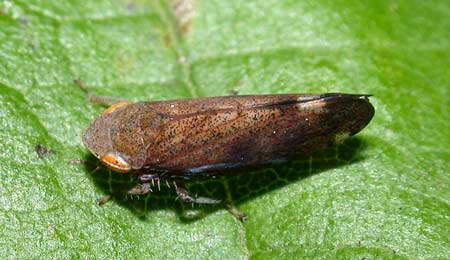 |
|||||
| Fieberiella florii (Stäl, 1864) [Auchenorrhyncha: Cicadellidae] | |||||
| References: | |||||
|
Alma, A. 2002. Auchenorrhyncha as pests on grapevine. Denisia 4, 176:531-538. |
|||||
| Arzone, A., A. Alma 2000. Insetti vettori di fitoplasmi in Europa. Conoscenze, acquisizoni, aspettative. Petria, 10:121-127. | |||||
| Biedermann R., R, Niedringhaus 2004. Die Zikaden Deutschlands - Bestimmungstafeln für alle Arten. Scheessel, WABV-Fründ, p. 409. | |||||
| EPPO-dsqpSTOL: http://www.eppo.org/QUARANTINE/bacteria/Stolbur/PHYP10_ds.pdf | |||||
| EPPO Reporting Service, 2004: http://www.eppo.org/PUBLICATIONS/reporting/Rse-0412.pdf | |||||
| Holzinger W.E.,I. Kammerlander, H. Nickel 2003. The Auchenorrhyncha of Central Europe, Fulgoromorpha, Cicadomorpha excl. Cicadellidae. Brill, Leiden, p.673. | |||||
|
Lessio F., S. Palermo, R. Tedeschi and A. Alma. 2003. Presence of grapevine yellows phytoplasmas vectors (Homoptera, Auchenorrhyncha) in Northwestern Italy. 14th ICVG Conference, Locorotondo 12-17 Sept., 75-76. |
|||||
| Palermo S., M. Elekes, S. Botti, I. Ember, A. Alma, A. Orosz, A. Bertaccini and M. Kölber. 2004. Presence of Stolbur phytoplasma in Cixiidae in Hungarian viticulture. Vitis 43 (4), in press. | |||||
|
Department of Plant Pests, Institute for Plant Protection and Environment Belgrade Banatska 33, Zemun, tel/fax: 011 2611 762, E-mail: titanus_serbia@hotmail.com |
|||||
|
|
|||||
